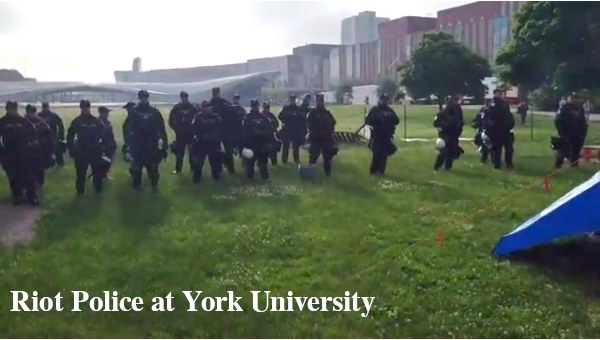The Not So Negative Dialectics of Post-Secondary Education
“Well, we busted out of class,
had to get away from those fools.
We learned more from a three-minute record, baby,
than we ever learned in school.”
— Bruce Springsteen
“Who built Thebes of the seven gates?
In the books you will find the names of kings.
…
Every page a victory.
Who cooked the feast for the victors?
Every ten years a great man?
Who paid the bill?
So many reports.
So many questions.”
— Bertolt Brecht
Post-secondary education is marketed, and widely seen, as human capital investment. Obtaining a college or university degree today will yield a skill-premium tomorrow. And a possible gain in social status or, if coming from the educated classes, at least retention of the status of one’s parents. Marketing and expectations of pecuniary and status gains are sometimes complemented by hints at post-secondary education as a pathway to becoming a good citizen. At its most emphatic, such as invoked by Kant’s definition of enlightenment, suggesting that post-secondary education is the indispensable guide to emerge from (..) self-incurred immaturity.

HR departments, without going so far as to invoke dead philosophers, echo the marketing of post-secondary education as being about more than naked self-interest by portraying their well-educated and equally well-motivated employees as their most valuable assets. It’s unlikely that they mean that they only hire people who produce surplus value for the company, even though producing surplus value is the sine qua non for hiring any worker in a capitalist company. HR departments wrap commitments to shareholder value into the idea that stakeholders of a company all share the same values that surely transcend callous cash payments.
Human Capital Investments or the Greater Good
Some students buy into the marketing efforts of post-secondary executives and HR departments. However, those who have to work all kinds of jobs to make it through college or university may second guess HR-talk about highly valuing their employees. For most jobs it doesn’t translate into high, or at least decent, pay. Of course, most students would prefer high-paying over low-paying jobs. But they might be ok with low pay while studying toward their degrees as long as they still expect skill premia coming in once they start degree-requiring jobs. The only problem is that the supply of degree-holding job applicants is far greater than the number of openings of these well-paying jobs. Employers can hire workers with degrees even in jobs where the degrees aren’t required and pay is low. At the same time, the cost of post-secondary education is increasing. As a result, the rate of return on human capital investments decreases. Even students who don’t care about anything other than the cost and benefits of their education investments have reasons to be disturbed.
There are also other students, of course, who value learning as an end in itself as much, or even more, than the formal degree they will eventually obtain. They might be puzzled by the contradiction between education as investment in skill premia and as contribution to some greater good. Wouldn’t that include, they might wonder, economic equality, a goal at odds with wanting more money than others who also work as hard, if not harder, than post-secondary graduates? Unequal access to post-secondary education and unequal conditions of study can only add to such puzzlement. Yet, finding courses that provide the space to turn puzzlement into more specified questions and possibly find some, if only tentative, answers are hard to find. Most course offerings focus on subjects allegedly boosting students’ future employability, regardless of diminishing returns on human capital investments.
Whether it is concerns about these diminishing returns, puzzlement about the contradictions between education as investment and as contribution to something beyond personal career development, or some twisted mix between these two, unease about going to college or university seems to be unavoidable. Cognitive dissonance permeates campuses. Not just amongst students. Compared to the janitors, kitchen and administrative staff who provide essential services on campus, educators have for a long time earned the skill premia that post-secondary executives are still promising students today. However, over the last decades, numbers of well-paying jobs in teaching and research have gone down, numbers of low-paid, mostly temporary jobs have gone up. The increasing polarization of jobs that marks the outside world prevails on campuses, too. Increasing gaps in terms of incomes and job security are complemented with increased top-down control, standardization, and automation of work. Fears of teaching bots and massive open online courses replacing face-to-face teaching entirely may be exaggerated but still shape today’s work experiences in post-secondary as much as fears about job prospects shape students’ learning experiences. Cognitive dissonance prevails on both sides.
Administrators, Students and Teachers
When it comes to post-secondary executives putting administrative and fiscal pressures on students and teachers, the latter two groups are on the same side. At the same time, teaching staff have to deal with students’ grade expectations that only get higher as the marketing of higher education as a good investment in one’s own future departs further and further from actual returns on these investments. Straddling the ‘grade-expectations-performance’-gap easily strains the relations between students and teachers. More precisely, it reveals that, when it comes to student evaluation, teachers are in a position of power over their students. This power is more limited than that which employers have over their employees, but still, the teacher-student relationship bears some resemblance with employment-relationships. The contradictory relations between students and teachers, facing similar pressures from post-secondary executives while at the same time teachers exert some power over students, is another source of cognitive dissonance, as it belies the idea of the university, not so much the more down-to-earth colleges, as a community of scholars committed to critical inquiry and truth. Any such commitments have to reckon with contradictions, hierarchies, and power-relations within the institutions of post-secondary education and between those institutions and their outside world that produces various forms of alienation and cognitive dissonance. This is structural; denial only makes it worse.
This being the case, teaching should aim at helping students to cope with cognitive dissonance. Being able to do so can only help them to find out how to make their way in the off-campus world that also is full of contradictions, and marked by power-relations and alienation. One of the first teaching goals should be the deconstruction of the idyllic images that post-secondary marketing and HR departments paint about the value of higher education and well-paying, fulfilling jobs. Awareness of not so nice realities is actually a good starting point for students charting their own paths to learning and life more generally. On the first parts of students’ learning journeys, teachers can offer a bit of guidance, not by showing students the way, or telling them what’s wrong and what’s right, but by encouraging them to figure out for themselves where they want to go and what’s wrong and right.
There is More to the Picture Than Meets the Eye
A first signpost on that path would point out that there is more to the picture than meets the eye. This should be obvious from the discrepancy between the images that marketers paint of post-secondary education and the jobs it helps to get, and the realities of austerity on campuses and beyond. However, cutting through such images is difficult in societies where the culture industry has co-opted the idea of enlightenment and turned it into a vehicle of mass deception. The reach of this industry is so wide that anyone challenging its messages, if only by confronting them with empirical data, easily comes across as a crank. Not the most inviting prospect for aspiring students. Moreover, an age of diminished expectations creates its own incentives to avoid inconvenient realities. Why confront oneself with reality if there is little hope for improvement? Cognitive dissonance is prevalent. But so are attempts to escape it. Making clear to students that learning happens outside of ones’ comfort zone, that cognitive dissonance is a starting point to explore reality, and that such explorations are actually exciting because they don’t deliver comforting truths, is a real teaching challenge.
The attraction of comforting truths constitutes another challenge that leads to signpost two: Beware the pretense of knowledge. Knowledge can draw on observations and critical reflection that allows learners, students, and teachers alike, to position themselves in the world in such a way that they can pursue their interests and happiness. However, if one doesn’t expect this to be possible, knowledge can also be used, or, from the perspective of enlightenment philosophy, misused, to escape the real world and seek refuge in reassuring certainties, in the most extreme eternal truths protected against critical inquiries by ‘alternative facts.’ By making their own history, humans change already existing circumstances. Whether they, or only some of them, are aware of their history-making and circumstance-changing doesn’t matter. Looking back, it is rather obvious that an interplay of actions and reactions changed the world, and there is no reason to assume that this will stop. If it doesn’t, ongoing changes challenge received wisdoms over and over again. What might have been persuasive under one set of circumstances could be less than persuasive under different circumstances.
Put Yourself Into Somebody Else’s Boots
Changing circumstances are one reason to be wary of anyone pretending to know eternal truths. Differences of perspective are another. People looking at the same thing from different angles see it differently. Therefore, signpost three on the learning path suggests putting oneself in somebody else’s boots. Look at a bunch of soccer players, for example. Even if everybody plays by the same rules, playing on an unequal field distributes the chances of winning unevenly. Therefore, players with high chances of winning want to keep the field unequal and, if necessary, change the rules in such a way that this goal can be achieved. Most likely, they are the rule-makers who can actually do this. Players with lower chances of winning, on the other hand, are more likely rule-takers who may not like to run around the most difficult parts of the field but see little chance of imposing rules that would either level the playing field or at least give some of them the chance to make it to greener pastures some of the time. That rule-makers and rule-takers see the same field differently shouldn’t be a surprise. The point is not that one side is right and the other wrong. In their own ways, both may be right – but only partially. As realities are multi-faceted, the truth is in the whole. Which does not mean that it is eternal. After all, as signpost two said, realities change and so does the truth about them.
Learners also change. Reason enough to amend the idea of putting oneself into somebody else’s boots to signpost four: Take a look at yourself. After a few steps on your learning path, you may see things differently. Equipped with some new ideas, you may also look at experiences outside the classroom and beyond campus. A fresh look at experiences slumbering somewhere in your memory can bring them to life so that they can contribute to what’s learned in the classroom. Reflection about your learning and life experiences is part of the journey. A few basic principles will help you to chart your own course beyond the signposted path set up by a teacher: Analyse, synthesize, and contextualize. These very general principles are adjustable to all junctures and cross-roads that you will encounter during your journey. While you chart your own course, you should not forget that there are always paths not taken, insights not found. At least not yet. There is always something new to discover. That is why a learning journey is unending, may sometimes wear you out – but is always interesting. •





